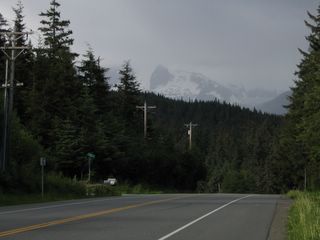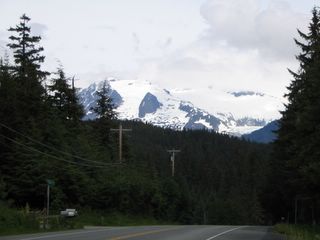Walking Alaskan Bedrock
Alive in the Sea of Information
with a wink and a nod to Gary Snyder*
Spruce, hemlock, pine
Rain—fine droplets—rising and falling
Walk around puddles
stones worn free in the path.
Noiseless drizzle (lush moss)
Silent poison blushing crimson
Trudge on and upward; slick rock terraces
Bare of lichen, adorned
With cabled hoop earrings
Rusting like the uplifted pyrite
exposed.
Descend into the silent woods:
Alder, moss, mud, glazing rain.
Waterproof jacket, pants, boots—
Frothy mountain streams taken in a leap
Gridlock in a teenage forest:
inch forward
to a glistening rocky descent
Scenic trail—bookmark it!
A well-worn path dips down to the edge of a glacial lake—
bushwhack to skirt the flooded trench
Ten literary scholars following
a geologist, a biologist, and their pedagogue
Jagged rockface ripped by a receding glacier
Above, the uplifted rock ground smooth
But for a grooved fingerprint
The scored mirror of a frozen Sea
Of Information.
Lichen and clear pools
Slabs of smoothed rock
And in between, mineral-rich detritus
Like the dust between the floorboards the broom ignores
Tenacious fireweed in miniature at a mid-summer full bloom
Alder cones patiently waiting for nitrogen—
breathe.
Sliding rock with only a film of dewy rain
And below, flowing ice
Frozen in the impassive scene and inaccurate memories.
Cameras at the ready, scramble down:
white sheet, depressions, hollows, tunnels—
rock gives way
to mud the color of cement and as packed with gravel—
an arch carved in the ice, a subterranean stream,
the cave its rising steam expands—
crouch on the ground
in the frigid air
beneath a Sea
of Information;
wipe melted data
from the digital photographic apparatus—
electric blue.
Appointments loom more impressively than the ice cliffs
The obvious path unintelligible, walk into the wild
Move, pause, move*
Ridge-top view of unnoticed gullies
a large pool
stepping stones
Resume the trail;
Seek the shelter of an open-air shed.
Cool mist and friends
Rivulets down cheeks
One story—thirteen tongues
Alive in the liquid Sea of Information.
*Gary Snyder, “Walking the New York Bedrock Alive in the Sea of Information,” The Gary Snyder Reader, 1999, New York: Counter Point, 2000. 587-91.





